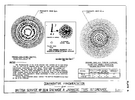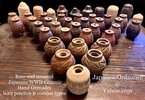What was the purpose of the recessed 'teardrop' patterning on the top face of body of these grenades? I had at first thought that it was decorative as surely it was not intended to aid fragmentation, given that this area of the grenade would not be expected to fragment, right? Assume red paint applied to this area denotes that it is filled, or identify a specific filling?
British Ordnance Collectors Network
You are using an out of date browser. It may not display this or other websites correctly.
You should upgrade or use an alternative browser.
You should upgrade or use an alternative browser.
Japanese Type 91 and Type 97 grenades
- Thread starter batonroundcollector
- Start date
The teardrops might be to assist fragmentation, although probably not very effective, as the earlier Type 10 was designed to fragment the top as well as the sides of the body.
Eggburt1969
Well-Known Member
A comparison of the fragmentation produced by the detonation of a Type 97 hand grenade and a British No. 36M is is below. Both are cast iron bodied grenades with external grooves. The image is taken from the 1945 C.I.AMN report 'JATR-No 05 - Discharger, HE, Type 91 and Grenade, Hand, HE, Type 97'.
As can been seen the grooves do not, in general, control the fragmentation process to any real degree. Though the grooves will act as stress risers, they should be on the inside surface to control the body's fragmentation. For maximal effect the grooves should be far smaller and the casing thinner, though using standard cast iron with such a design may be problematic.
A thinner casing and body internal surface patterning (preferably on the top, bottom and sides) would result in more numerous and higher velocity fragments of a controlled weight. Though lighter, the higher velocity and greater number of fragments means such a grenade would be far more lethal. It would also minimise the highly dangerous larger longer-ranging fragments that both of the earlier design grenades produce.
As can been seen the grooves do not, in general, control the fragmentation process to any real degree. Though the grooves will act as stress risers, they should be on the inside surface to control the body's fragmentation. For maximal effect the grooves should be far smaller and the casing thinner, though using standard cast iron with such a design may be problematic.
A thinner casing and body internal surface patterning (preferably on the top, bottom and sides) would result in more numerous and higher velocity fragments of a controlled weight. Though lighter, the higher velocity and greater number of fragments means such a grenade would be far more lethal. It would also minimise the highly dangerous larger longer-ranging fragments that both of the earlier design grenades produce.
Attachments
Yes I know that fragmentation doesn't in effect follow grooves (and therefore nor the 'teardrops') but I thought that might have been the belief and intention when designed. Not sure if this is true but apparently William Mills intended the grooves in his grenade as an aid to grip in muddy conditions and enhancing fragmentation wasn't a consideration...
Eggburt1969
Well-Known Member
I think it's like many things, just one of those technical misconceptions that the averaged person on the street gets fed by some mass media or other poor knowledge source. They get fed the error so many times that people end up thinkings it's correct; i.e. it become folklorical (folklore). You see them all the time, munition fragments being called shrapnel, incorrect use of the term and process of detonation, shaped charge jets burning through the target, etc., etc...Yes I know that fragmentation doesn't in effect follow grooves (and therefore nor the 'teardrops') but I thought that might have been the belief and intention when designed. Not sure if this is true but apparently William Mills intended the grooves in his grenade as an aid to grip in muddy conditions and enhancing fragmentation wasn't a consideration...
Eggburt1969
Well-Known Member
I completely misread the teardrops comment to be about the textured area around the middle? Must have been on another plate I guess?
As before though, yes they would act as stress-risers, but they would likely only have a limited effect of the fragmentation of the top closing plate/plug.
Some do look more like teardrops, or flower petals depending on your point of view, whereas others are far more angular.
As to if they represent the Imperial (chrysanthemum) seal of Japan. They seem to be the wrong way around to be the seal; i.e. the wider part is to the centre on the grenade, whereas for the seal the wider part is to the outer edge?
As before though, yes they would act as stress-risers, but they would likely only have a limited effect of the fragmentation of the top closing plate/plug.
Some do look more like teardrops, or flower petals depending on your point of view, whereas others are far more angular.
As to if they represent the Imperial (chrysanthemum) seal of Japan. They seem to be the wrong way around to be the seal; i.e. the wider part is to the centre on the grenade, whereas for the seal the wider part is to the outer edge?
Last edited:
No. Wrong shape, wrong orientation, and wrong number, so they can’t represent the petals of the Imperial chrysanthemum.Representative of the Chrysanthemum Throne perhaps.
I know that the idea of adding 'decorative' features to a grenade would be inconceivable for most militaries but perhaps not for the Japanese of that era? There's a definite artistry and quality to the ceramic grenades in the pic below, above and beyond what would be required for their function (presumably though these were made by craftsmen more used to making decorative items, as the war effort required, rather than by munitions factory workers)...
Attachments
Last edited:


